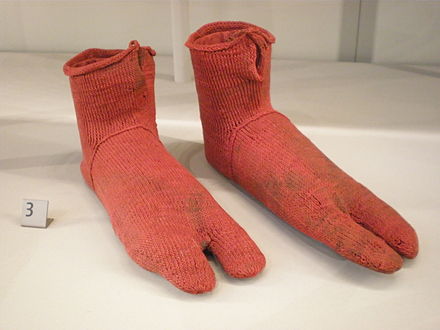Sock
A sock is a piece of clothing worn on the feet and often covering the ankle or some part of the calf. Some types of shoes or boots are typically worn over socks. In ancient times, socks were made from leather or matted animal hair. In the late 16th century, machine-knit socks were first produced. Until the 1800s, both man-made and machine-knit socks were manufactured, but the latter technique become more common in the 19th century.
One of the roles of socks is absorbing perspiration. As the foot is among the heaviest producers of sweat in the body, it can produce over 0.25 US pints (0.12 l) of perspiration per day;[1] socks help to absorb this sweat and draw it to areas where air can evaporate the perspiration. In cold environments, socks made from cotton or wool help warm up cold feet which in turn, helps decrease the risk of getting frostbite. Thin socks are most commonly worn in the summer months to keep feet cool. Light colored socks are typically worn with sports shoes and dark colored socks with dress shoes (often black or navy blue dress socks). In addition, dark colored socks absorbs heat which in turn helps keep the foot warm while light colored socks reflects heat which in turn helps the feet stay cool.
The modern English word sock is derived from the Old English word socc, meaning "light slipper". This comes from the Latin soccus, a term to describe a "light, low-heeled shoe" worn by Roman comic actors,[2] and deriving from the Ancient Greek word sykchos.[3]
Socks have evolved over the centuries from the earliest models, which were made from animal skins gathered up and tied around the ankles. Because the manufacture of socks was relatively time-consuming in pre-industrial times, they were long used only by the rich. The poor wore footwraps, simple cloths wrapped around the feet. These remained in use in Eastern European armies until the end of the 20th century.
According to the Greek poet Hesiod, in the 8th century BC, the Ancient Greeks wore socks called "piloi", which were made from matted animal hair.[4] The Romans also wrapped their feet with leather or woven fabrics. Around the 2nd century AD, the Romans started sewing the fabrics together making fitted socks called "udones". By the 5th century AD, socks called "puttees" were worn by holy people in Europe to symbolize purity.
During the Middle Ages, the length of trousers was extended and the sock became a tight, brightly colored cloth covering the lower part of the leg. Since socks did not have an elastic band, garters were placed over the top of the stockings to prevent them from falling down. When breeches became shorter, socks began to get longer (and more expensive). By 1000 AD, socks became a symbol of wealth among the nobility. From the 16th century onwards, an ornamental design on the ankle or side of a sock has been called a clock.[5][6][7]






